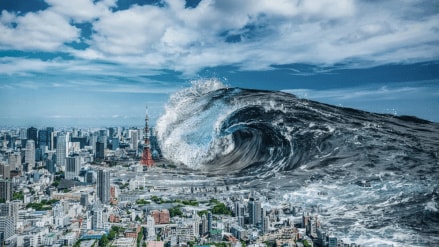When a massive 8.7 magnitude earthquake hit off Russia’s Kamchatka Peninsula on 30 July 2025, it induced a tsunami alert for part of Japan and the broader Pacific region. Although the waves that did reach Japan were not as severe as predicted, the sequence of events demonstrated the classic mechanism by which tsunamis are produced, and why countries along the Pacific ‘Ring of Fire’ are in such high states of readiness.
What causes a Tsunami?
Tsunamis, as learned from textbooks, are huge sea waves that are mainly triggered by the rapid vertical displacement of the seafloor. The most frequent cause, usually, is an earthquake that happens beneath the water in a subduction zone, i.e., one tectonic plate is pushed under another. When the tension stored due to the movement of the tectonic plates is released, the ocean floor is suddenly pushed up and down, hence displacing enormous amounts of water. This places the waves into a larger motion than usual.
Although earthquakes are the primary offenders, tsunamis can also be caused by underwater landslides, volcanic activity, or, in extreme situations, meteorite impacts.
What is the science behind such waves?
When the ocean is agitated as a result of the jolting, the moving water creates waves that are capable of travelling in all directions. In the deep sea water, such tsunami waves are able to move at speeds that frequently reach 800km/hour and have wavelengths that extend up to 200 km. As fast as these are, the waves tend to be only a meter high and can easily pass unnoticed by ships out at sea.
But the greatest threat is off the coast.
Once these waves travel into shallower waters, usually closer to the coast, they slow down because of friction against the ocean floor. This makes the water behind swell up, thus greatly raising the height of the wave. So, rather than breaking like surf waves, these tsunamis are in the form of quickly climbing walls that can inundate land.
What occurred in Kamchatka, Russia?
The Kamchatka earthquake on 30 July, measured at 8.7 magnitude, was among the strongest since 1952. The quake lifted the seafloor high, propelling tsunami waves that measured 4 meters or 13 feet in some areas of Russia. Japan’s meteorological agency issued warnings along its northern coastline immediately, leading to evacuations. Nemuro, Hokkaido, recorded waves of up to 30 cm, and advisories extended to Hawaii, Alaska, and even the U.S. West Coast.
Tsunamis may come without warning. But thanks to improved seismometer detection and early warning systems, nations such as Japan are more prepared than ever.
